Time Effects of Global Change on Forest Productivity in China from 2001 to 2017
Abstract
1. Introduction
2. Results
3. Discussion
4. Study Area and Methods
4.1. Data Collection
4.2. Data Analysis
Author Contributions
Funding
Data Availability Statement
Conflicts of Interest
References
- Sallaba, F.; Lehsten, D.; Seaquist, J.; Sykes, M.T. A Rapid NPP Meta-Model for Current and Future Climate and CO2 Scenarios in Europe. Ecol. Model. 2015, 302, 29–41. [Google Scholar] [CrossRef]
- Wieder, W.; Cleveland, C.; Smith, W.; Todd-Brown, K. Future Productivity and Carbon Storage Limited by Terrestrial Nutrient Availability. Nat. Geosci. 2015, 8, 441–444. [Google Scholar] [CrossRef]
- Gang, C.; Zhou, W.; Zhaoqi, W.; Chen, Y.; Li, J.; Chen, J.; Qi, J.; Odeh, I.; Groisman, P. Comparative Assessment of Grassland NPP Dynamics in Response to Climate Change in China, North America, Europe and Australia from 1981 to 2010. J. Agron. Crop Sci. 2014, 201, 57–68. [Google Scholar] [CrossRef]
- Liu, Y.; Wang, Q.; Zhang, Z.; Tong, L.; Wang, Z.; Li, J. Grassland Dynamics in Responses to Climate Variation and Human Activities in China from 2000 to 2013. Sci. Total Environ. 2019, 690, 27–39. [Google Scholar] [CrossRef] [PubMed]
- Chen, Y.; Chen, L.; Cheng, Y.; Ju, W.; Chen, H.Y.H.; Ruan, H. Afforestation Promotes the Enhancement of Forest LAI and NPP in China. For. Ecol. Manag. 2020, 462, 117990. [Google Scholar] [CrossRef]
- Naeem, S.; Zhang, Y.; Tian, J.; Qamer, F.M.; Latif, A.; Paul, P.K. Quantifying the Impacts of Anthropogenic Activities and Climate Variations on Vegetation Productivity Changes in China from 1985 to 2015. Remote Sens. 2020, 12, 1113. [Google Scholar] [CrossRef]
- Bi, X.; Li, B.; Zhang, L.; Nan, B.; Zhang, X.; Yang, Z. Response of Grassland Productivity to Climate Change and Anthropogenic Activities in Arid Regions of Central Asia. PeerJ 2020, 8, e9797. [Google Scholar] [CrossRef]
- Fang, K.; Wang, T.; He, J.; Wang, T.; Xie, X.; Tang, Y.; Shen, Y.; Xu, A. The Distribution and Drivers of PM2.5 in a Rapidly Urbanizing Region: The Belt and Road Initiative in Focus. Sci. Total Environ. 2020, 716, 137010. [Google Scholar] [CrossRef]
- Liu, S.; Xing, J.; Zhao, B.; Wang, J.; Wang, S.; Zhang, X.; Ding, A. Understanding of Aerosol–Climate Interactions in China: Aerosol Impacts on Solar Radiation, Temperature, Cloud, and Precipitation and Its Changes Under Future Climate and Emission Scenarios. Curr. Pollut. Rep. 2019, 5, 36–51. [Google Scholar] [CrossRef]
- Xu, X.; Niu, S.; Sherry, R.A.; Zhou, X.; Zhou, J.; Luo, Y. Interannual Variability in Responses of Belowground Net Primary Productivity (NPP) and NPP Partitioning to Long-Term Warming and Clipping in a Tallgrass Prairie. Glob. Chang. Biol. 2012, 18, 1648–1656. [Google Scholar] [CrossRef]
- Ruddiman, W.F. The Anthropocene. Annu. Rev. Earth Planet. Sci. 2013, 41, 45–68. [Google Scholar] [CrossRef]
- Azhdari, Z.; Rafeie Sardooi, E.; Bazrafshan, O.; Zamani, H.; Singh, V.P.; Mohseni Saravi, M.; Ramezani, M. Impact of Climate Change on Net Primary Production (NPP) in South Iran. Environ. Monit. Assess. 2020, 192, 409. [Google Scholar] [CrossRef]
- Sun, Y.; Yang, Y.; Zhao, X.; Tang, Z.; Wang, S.; Fang, J. Global Patterns and Climatic Drivers of Above- and Belowground Net Primary Productivity in Grasslands. Sci. China Life Sci. 2021, 64, 739–751. [Google Scholar] [CrossRef] [PubMed]
- Liu, H.; Mi, Z.; Lin, L.; Wang, Y.; Zhang, Z.; Zhang, F.; Wang, H.; Liu, L.; Zhu, B.; Cao, G.; et al. Shifting Plant Species Composition in Response to Climate Change Stabilizes Grassland Primary Production. Proc. Natl. Acad. Sci. USA 2018, 115, 4051–4056. [Google Scholar] [CrossRef]
- Yang, D.; Zhang, H.; Li, J. Changes in Concentrations of Fine and Coarse Particles under the CO2-Induced Global Warming. Atmos. Res. 2019, 230, 104637. [Google Scholar] [CrossRef]
- Zhang, Z.; Wang, X.; Cheng, S.; Guan, P.; Zhang, H.; Shan, C.; Fu, Y. Investigation on the Difference of PM2.5 Transport Flux between the North China Plain and the Sichuan Basin. Atmos. Environ. 2022, 271, 118922. [Google Scholar] [CrossRef]
- Zhang, C.; Ren, W. Complex Climatic and CO2 Controls on Net Primary Productivity of Temperate Dryland Ecosystems over Central Asia during 1980–2014. J. Geophys. Res. Biogeosciences 2017, 122, 2356–2374. [Google Scholar] [CrossRef]
- Meng, L.; Wu, J.; Feng, Y.; Niu, B.; He, Y.; Zhang, X. Climate Variability Rather Than Livestock Grazing Dominates Changes in Alpine Grassland Productivity Across Tibet. Front. Ecol. Evol. 2021, 9, 631024. [Google Scholar]
- Wei, X.; Yang, J.; Luo, P.; Lin, L.; Lin, K.; Guan, J. Assessment of the Variation and Influencing Factors of Vegetation NPP and Carbon Sink Capacity under Different Natural Conditions. Ecol. Indic. 2022, 138, 108834. [Google Scholar] [CrossRef]
- Cao, S.; Sanchez-Azofeifa, G.A.; Duran, S.M.; Calvo-Rodriguez, S. Estimation of Aboveground Net Primary Productivity in Secondary Tropical Dry Forests Using the Carnegie-Ames-Stanford Approach (CASA) Model. Environ. Res. Lett. 2016, 11, 075004. [Google Scholar] [CrossRef]
- Wang, Y.; Guo, C.; Chen, X.; Jia, L.; Guo, X.; Chen, R.; Zhang, M.; Chen, Z.; Wang, H. Carbon Peak and Carbon Neutrality in China: Goals, Implementation Path and Prospects. China Geol. 2021, 4, 720–746. [Google Scholar] [CrossRef]
- Du, Z.; Liu, X.; Wu, Z.; Zhang, H.; Zhao, J. Responses of Forest Net Primary Productivity to Climatic Factors in China during 1982–2015. Plants 2022, 11, 2932. [Google Scholar] [CrossRef] [PubMed]
- Hao, L.; Wang, S.; Cui, X.; Zhai, Y. Spatiotemporal Dynamics of Vegetation Net Primary Productivity and Its Response to Climate Change in Inner Mongolia from 2002 to 2019. Sustainability 2021, 13, 13310. [Google Scholar] [CrossRef]
- Zhang, M.; Liu, X.; Nazieh, S.; Wang, X.; Nkrumah, T.; Hong, S. Spatiotemporal Distribution of Grassland NPP in Gansu Province, China from 1982 to 2011 and Its Impact Factors. PLoS ONE 2020, 15, e0242609. [Google Scholar] [CrossRef]
- Li, H.; Wu, Y.; Liu, S.; Xiao, J. Regional Contributions to Interannual Variability of Net Primary Production and Climatic Attributions. Agric. For. Meteorol. 2021, 303, 108384. [Google Scholar] [CrossRef]
- Peng, J.; Dan, L. Impacts of CO2 Concentration and Climate Change on the Terrestrial Carbon Flux Using Six Global Climate–Carbon Coupled Models. Ecol. Model. 2015, 304, 69–83. [Google Scholar] [CrossRef]
- Ju, W.M.; Chen, J.M.; Harvey, D.; Wang, S. Future Carbon Balance of Chinas Forests under Climate Change and Increasing CO2. J. Environ. Manag. 2007, 85, 538–562. [Google Scholar] [CrossRef]
- Jiang, D.; Sui, Y.; Lang, X. Timing and Associated Climate Change of a 2 °C Global Warming. Int. J. Climatol. 2016, 36, 4512–4522. [Google Scholar] [CrossRef]
- Baig, S.; Medlyn, B.E.; Mercado, L.M.; Zaehle, S. Does the Growth Response of Woody Plants to Elevated CO2 Increase with Temperature? A Model-Oriented Meta-Analysis. Glob. Chang. Biol. 2015, 21, 4303–4319. [Google Scholar] [CrossRef]
- Gu, F.; Zhang, Y.; Huang, M.; Tao, B.; Guo, R.; Yan, C. Effects of Climate Warming on Net Primary Productivity in China during 1961–2010. Ecol. Evol. 2017, 7, 6736–6746. [Google Scholar] [CrossRef]
- Ofiti, N.O.E.; Zosso, C.U.; Soong, J.L.; Solly, E.F.; Torn, M.S.; Wiesenberg, G.L.B.; Schmidt, M.W.I. Warming Promotes Loss of Subsoil Carbon through Accelerated Degradation of Plant-Derived Organic Matter. Soil Biol. Biochem. 2021, 156, 108185. [Google Scholar] [CrossRef]
- Maslov, M.N.; Maslova, O.A. Nitrogen Limitation of Microbial Activity in Alpine Tundra Soils along an Environmental Gradient: Intra-Seasonal Variations and Effect of Rising Temperature. Soil Biol. Biochem. 2021, 156, 108234. [Google Scholar] [CrossRef]
- Michaletz, S.; Cheng, D.; Kerkhoff, A.; Enquist, B. Convergence of Terrestrial Plant Production across Global Climate Gradients. Nature 2014, 512, 39–43. [Google Scholar] [CrossRef] [PubMed]
- Acuña-Rodríguez, I.S.; Newsham, K.K.; Gundel, P.E.; Torres-Díaz, C.; Molina-Montenegro, M.A. Functional Roles of Microbial Symbionts in Plant Cold Tolerance. Ecol. Lett. 2020, 23, 1034–1048. [Google Scholar] [CrossRef] [PubMed]
- Walker, T.W.N.; Kaiser, C.; Strasser, F.; Herbold, C.W.; Leblans, N.I.W.; Woebken, D.; Janssens, I.A.; Sigurdsson, B.D.; Richter, A. Microbial Temperature Sensitivity and Biomass Change Explain Soil Carbon Loss with Warming. Nat. Clim. Chang. 2018, 8, 885–889. [Google Scholar] [CrossRef] [PubMed]
- Guo, X.; Zuo, X.; Yue, P.; Li, X.; Hu, Y.; Chen, M.; Yu, Q. Direct and Indirect Effects of Precipitation Change and Nutrients Addition on Desert Steppe Productivity in Inner Mongolia, Northern China. Plant Soil 2022, 471, 527–540. [Google Scholar] [CrossRef]
- Wang, X.; Wang, J.; Zhang, L.; Lv, C.; Liu, L.; Zhao, H.; Gao, J. Climatic Factors Determine the Distribution Patterns of Leaf Nutrient Traits at Large Scales. Plants 2022, 11, 2171. [Google Scholar] [CrossRef]
- Wang, Y.; Li, H.; Feng, J.; Wang, W.; Liu, Z.; Huang, L.; Yaluk, E.; Lu, G.; Manomaiphiboon, K.; Gong, Y.; et al. Spatial Characteristics of PM2.5 Pollution among Cities and Policy Implication in the Northern Part of the North China Plain. Atmosphere 2021, 12, 77. [Google Scholar] [CrossRef]
- Lin, Y.; Yuan, X.; Zhai, T.; Wang, J. Effects of Land-Use Patterns on PM2.5 in Chinas Developed Coastal Region: Exploration and Solutions. Sci. Total Environ. 2020, 703, 135602. [Google Scholar] [CrossRef]
- Piao, S.; Sitch, S.; Ciais, P.; Friedlingstein, P.; Peylin, P.; Wang, X.; Ahlström, A.; Anav, A.; Canadell, J.G.; Cong, N.; et al. Evaluation of Terrestrial Carbon Cycle Models for Their Response to Climate Variability and to CO2 Trends. Glob. Chang. Biol. 2013, 19, 2117–2132. [Google Scholar] [CrossRef]
- Maschler, J.; Bialic-Murphy, L.; Wan, J.; Andresen, L.C.; Zohner, C.M.; Reich, P.B.; Lüscher, A.; Schneider, M.K.; Müller, C.; Moser, G.; et al. Links across Ecological Scales: Plant Biomass Responses to Elevated CO2. Glob. Chang. Biol. 2022, 28, 6115–6134. [Google Scholar] [CrossRef] [PubMed]
- Keenan, T.F.; Luo, X.; Kauwe, M.G.; Medlyn, B.E.; Prentice, I.C.; Stocker, B.D.; Smith, N.G.; Terrer, C.; Wang, H.; Zhang, Y.; et al. RETRACTED ARTICLE: A constraint on historic growth in global photosynthesis due to increasing CO2. Nature 2021, 600, 253–258. [Google Scholar] [CrossRef] [PubMed]
- Brienen, R.J.W.; Caldwell, L.; Duchesne, L.; Voelker, S.; Barichivich, J.; Baliva, M.; Ceccantini, G.; Di Filippo, A.; Helama, S.; Locosselli, G.M.; et al. Forest Carbon Sink Neutralized by Pervasive Growth-Lifespan Trade-Offs. Nat. Commun. 2020, 11, 4241. [Google Scholar] [CrossRef]
- Needham, J.F.; Chambers, J.; Fisher, R.; Knox, R.; Koven, C.D. Forest Responses to Simulated Elevated CO2 under Alternate Hypotheses of Size- and Age-Dependent Mortality. Glob. Chang. Biol. 2020, 26, 5734–5753. [Google Scholar] [CrossRef] [PubMed]
- Gao, J.; Ji, Y.; Zhang, X. Net primary productivity exhibits a stronger climatic response in planted versus natural forests. For. Ecol. Manag. 2023, 529, 120722. [Google Scholar] [CrossRef]
- Zhong, J.; Zhang, X.; Gui, K.; Liao, J.; Fei, Y.; Jiang, L.; Guo, L.; Liu, L.; Che, H.; Wang, Y.; et al. Reconstructing 6-Hourly PM2.5 Datasets from 1960 to 2020 in China. Earth Syst. Sci. Data 2022, 14, 3197–3211. [Google Scholar] [CrossRef]
- Huang, W.; Ding, Y.; Wang, S.; Song, C.; Wang, F. Growth and Development Responses of the Rhizome-Root System in Pleioblastus pygmaeus to Light Intensity. Plants 2022, 11, 2204. [Google Scholar] [CrossRef]

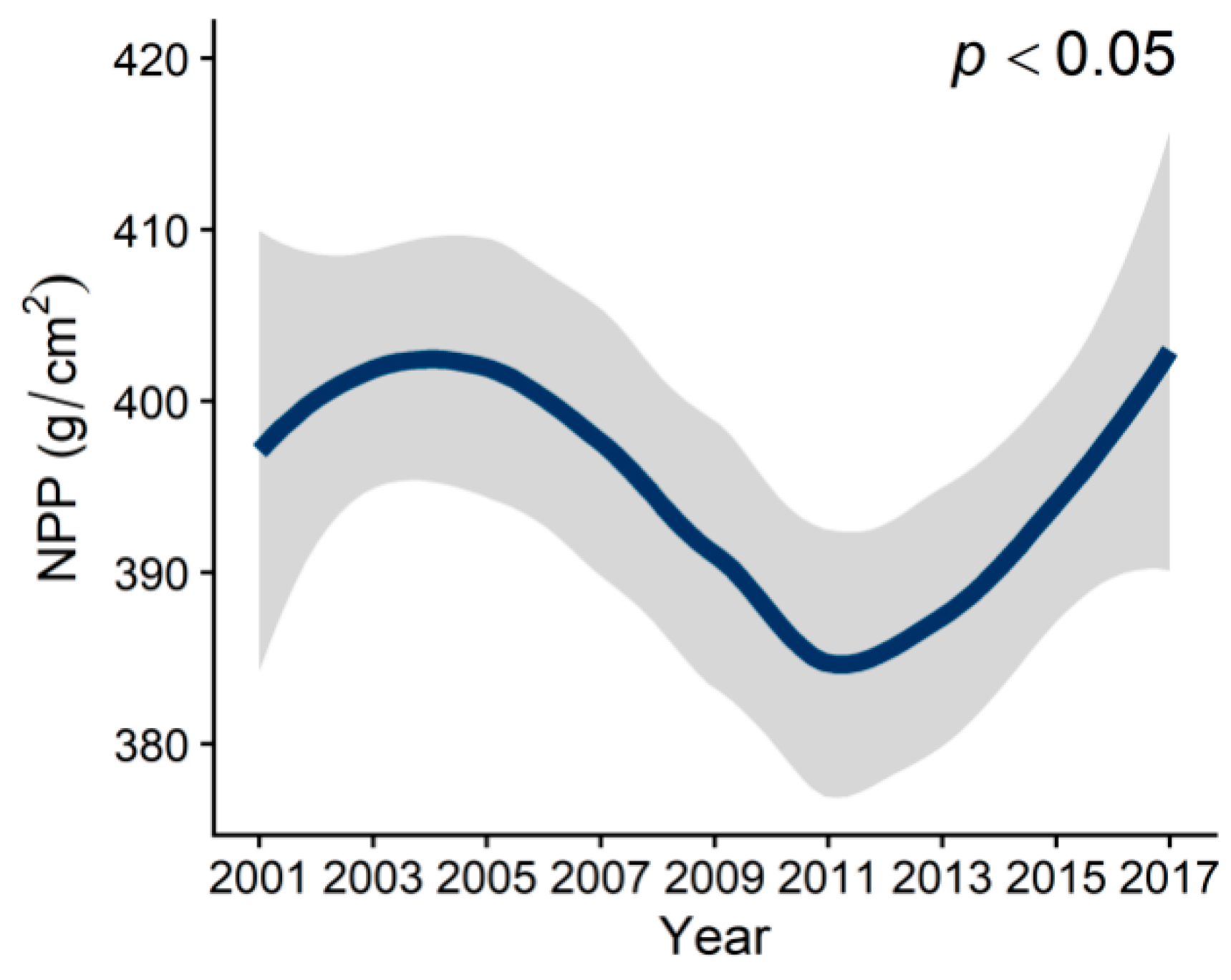
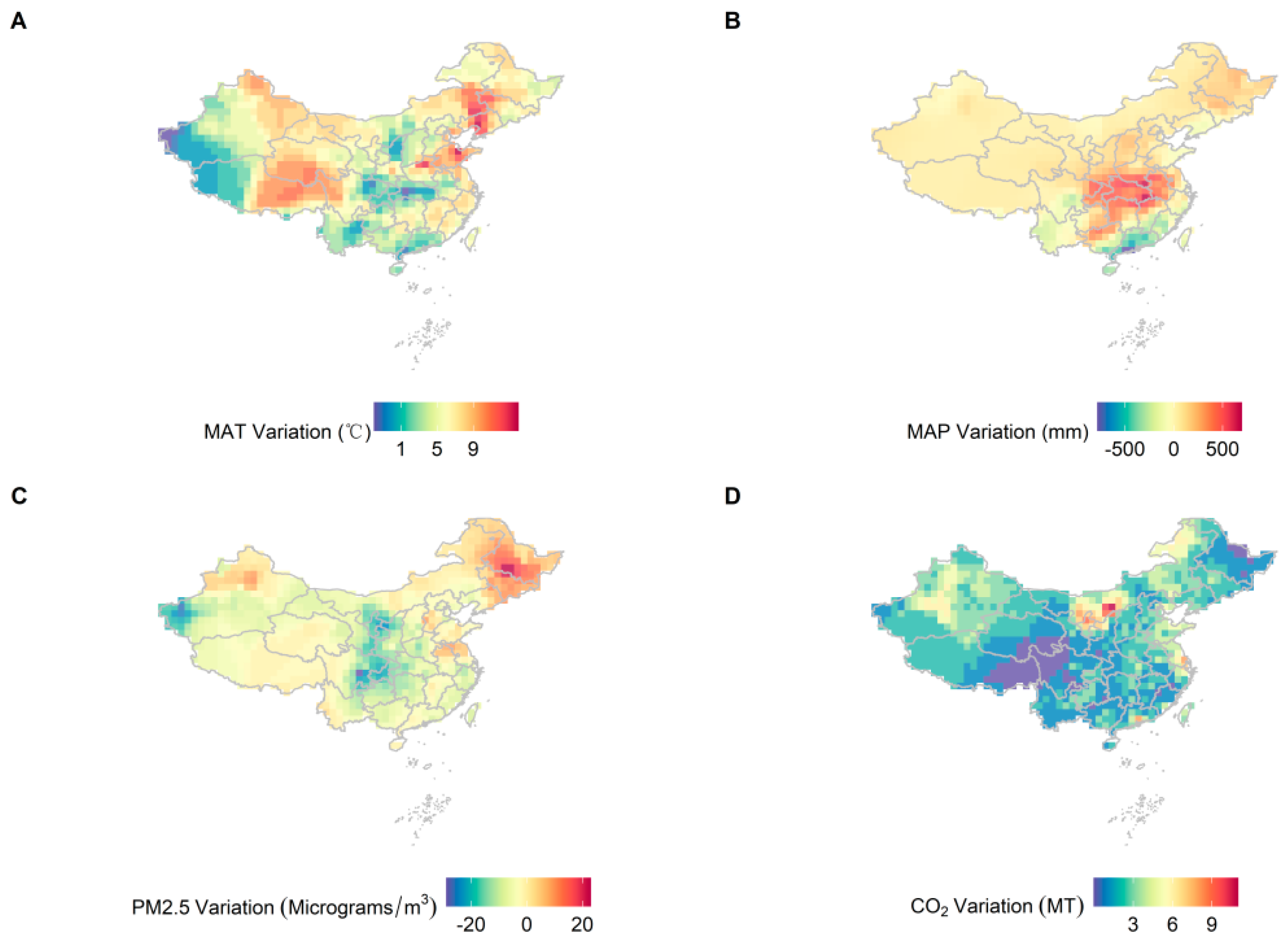
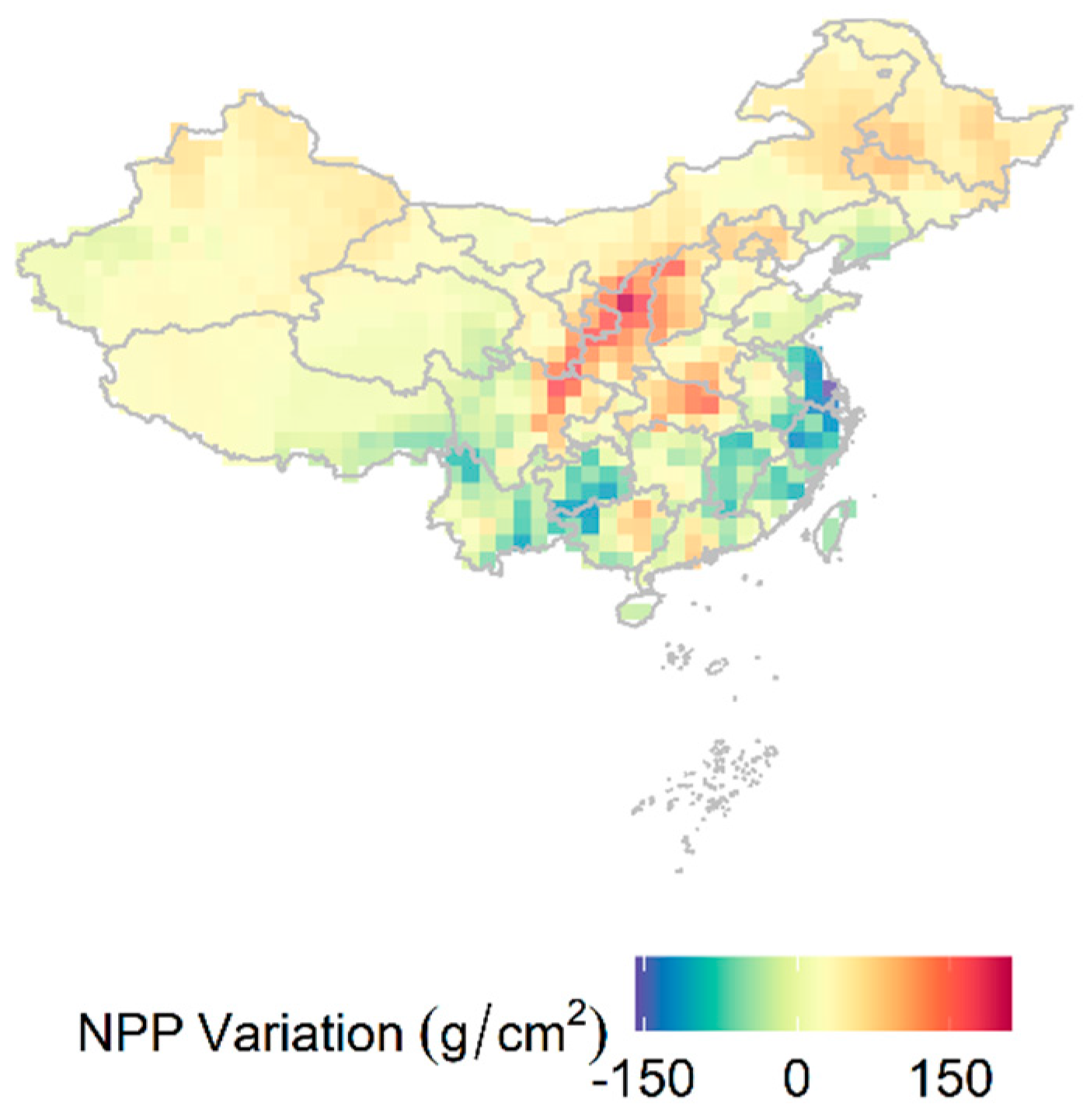

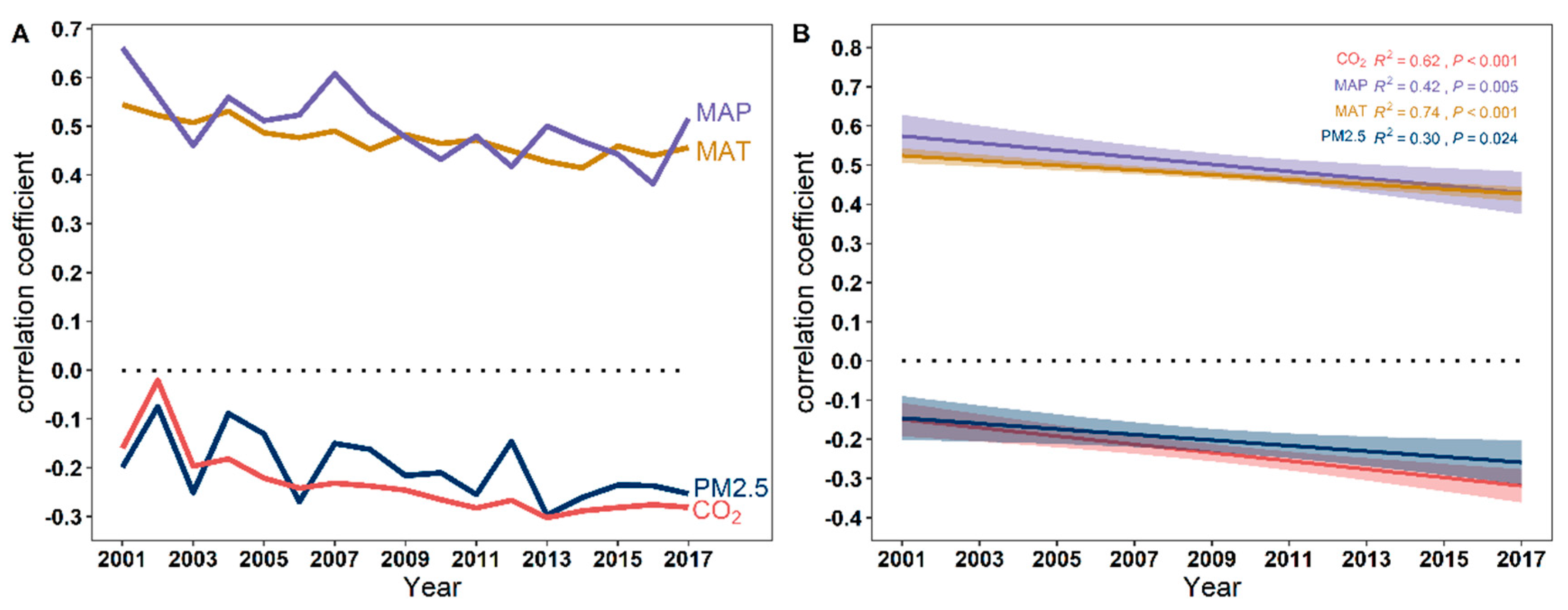
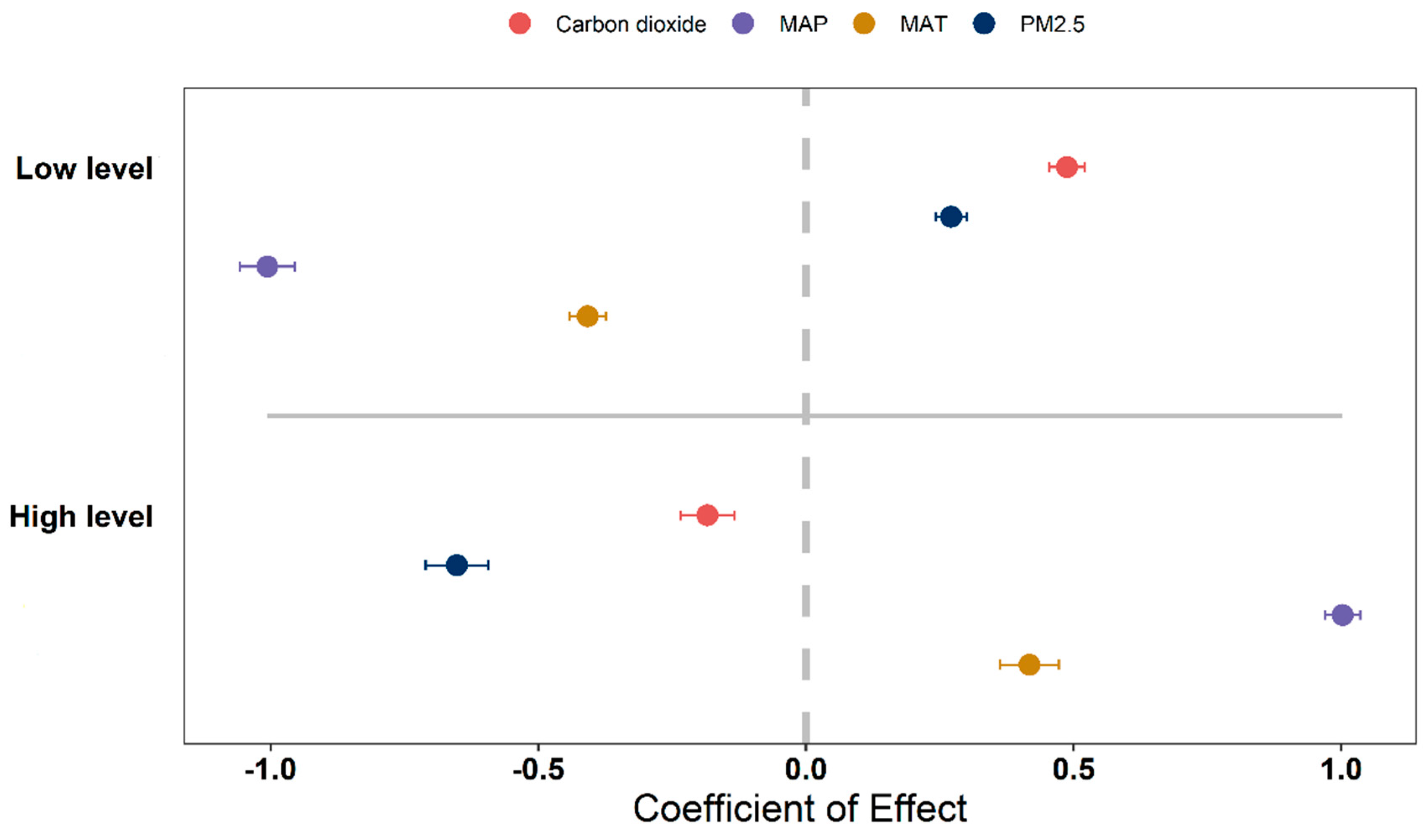
Disclaimer/Publisher’s Note: The statements, opinions and data contained in all publications are solely those of the individual author(s) and contributor(s) and not of MDPI and/or the editor(s). MDPI and/or the editor(s) disclaim responsibility for any injury to people or property resulting from any ideas, methods, instructions or products referred to in the content. |
© 2023 by the authors. Licensee MDPI, Basel, Switzerland. This article is an open access article distributed under the terms and conditions of the Creative Commons Attribution (CC BY) license (https://creativecommons.org/licenses/by/4.0/).
Share and Cite
Wang, J.; Li, Y.; Gao, J. Time Effects of Global Change on Forest Productivity in China from 2001 to 2017. Plants 2023, 12, 1404. https://doi.org/10.3390/plants12061404
Wang J, Li Y, Gao J. Time Effects of Global Change on Forest Productivity in China from 2001 to 2017. Plants. 2023; 12(6):1404. https://doi.org/10.3390/plants12061404
Chicago/Turabian StyleWang, Jiangfeng, Yanhong Li, and Jie Gao. 2023. "Time Effects of Global Change on Forest Productivity in China from 2001 to 2017" Plants 12, no. 6: 1404. https://doi.org/10.3390/plants12061404
APA StyleWang, J., Li, Y., & Gao, J. (2023). Time Effects of Global Change on Forest Productivity in China from 2001 to 2017. Plants, 12(6), 1404. https://doi.org/10.3390/plants12061404





